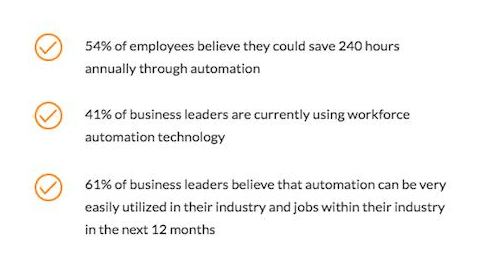
The last two decades have seen businesses grow exponentially. This growth can be attributed to the different tactics employed by shrewd business owners to try and maximize their profits.
Technological improvements and advancements in various fields, which now allow businesses to automate most of their day-to-day tasks, have also, in one way or another, fueled this growth.
Automation in business has helped companies in various sectors such as medicine, engineering, transport, service, hospitality, and more.
It has, in turn, had a positive impact on their competitiveness in their respective industries.
It gets better.
Such a positive outlook on businesses has also positively impacted on the quality of goods and services.
Consumers are now increasingly enjoying better quality products and services, thanks to automation.
It’s a well-known fact that automation continues to be used to improve product standards control.
It has also significantly enabled businesses to scale up their production capacity.
Why?
Because with automation, they can churn out probably even ten times (or even more) the amount of products humans would per production cycle.
Automated machines or processes are, therefore, more efficient than humans in terms of productivity and time.
The use of robots and automated internal business processes has disrupted the business world. With minimal or no supervision, they can fully manage, operate, or manipulate tasks.
This remarkably cuts down on production cost as one automated process delivers better results.
Process automation also allows for consistency in product or service delivery. Therefore, you can be assured of quality.
Also, if one machine operates the same as a hundred people, you no longer need that much manpower. Think about how much that can do for your business.
The money used to pay wages can be channeled elsewhere in your business. You also save on materials since machines work with programmed requirements.
In this case, wastage is kept at a minimum. Automation has significantly cut down on cost. But according to a Gartner study, some IT executives still feel that their organizations are not ready to automate. Many cite complex technology as one of the main reasons.
Automation can turn around your slow business into a money maker in no time. However, despite its perks, automation comes with a few obstacles as well.
5 Automation Challenges You May Face

As you plan to integrate automation in your business, it’s important that you familiarize yourself with some of the challenges and how they might impact your business.
1. Cost implications
Being a highly powered electronic system, automation comes at a cost. Specific systems are developed by IT specialists to suit certain industries. This means that you have to invest heavily in getting one or a couple of systems that meet your company’s needs.
Apart from purchasing the software, expertise is needed in handling and implementing automation. For this, you may need to either outsource the work to a professional or train your employees.
Like any other electronic or computer device, automated systems require monitoring and maintenance to prevent sudden malfunctions. Outsourcing companies that mainly deal with automation come highly recommended.
2. Is automation a threat to employment?
Well, there are two schools of thought to this. While many might think that automation is replacing human labor, others argue that it has created more opportunities.
According to Grant Thornton, global hiring expectations were expected to surge by up to 11 points in 2018 to reach 40 percent.

Image Source: Grant Thornton
On the other hand, modern technology has come up with many tools that seem to mimic human behavior. Automation tools fall squarely under this scheme of things. For employees, automation does not entirely come as a plus to their portfolio.
Instead, it places them at risk of becoming a liability. As more industries continue to automate their departments and process, many people may need to change jobs or learn new skills.
A McKinsey Global Institute report argues that automation will displace many jobs over the next ten to 15 years.

Image Source: McKinsey.com
After all, if a machine can do more than half their tasks, what is the point of the company retaining them? With the efficiency and reliability that automation brings, automation is also highly ranked. The idea that automation is of more value than humans de-motivates and makes employees feel that their status in the firm is at risk.
3. Sustainability may be a challenge
Before choosing or even settling for automated tools, you must consider what it entails to automate your business.
Can you keep up with the industry trends? Is your business stable enough for such technology? Can you maintain the automation tools? Do you have the in-house expertise required to handle these solutions? Will automation replace your employees? Will automation improve or simply burden your business?
Automation may seem like a good idea, but it is not ideal for everyone. With factors such as cost, employees, customer experience, among others, automation can be a handful.
For companies that are coming up or require more hands on deck, automation may not be the best option.
4. Automation comes with its own set of security risks
Most databases are comprised of consolidated information, including customer’s personal data and confidential business documents. This is very vital and sensitive information, which could be quite damaging if it lands in the wrong hands.
Any computer system is liable to hacking and other malicious attacks. With such crucial information in one place, your company also runs the risk of getting dragged into court if customer/employee confidential details leak. Automated systems could also malfunction or simply crash, leading to major losses and damage.
5. Some automation tools are not user-friendly
Automation tools have rapidly grown from just performing one simple task to executing more complex tasks. Although this should be a plus, it has a downside. The more complex the tool, the less user-friendly it is.
This means that fewer people can operate this tool with ease and may require more expertise and caution to handle. Overall, some employees, as well as companies, may simply keep of such systems to avoid going to lengths of outsourcing experts or conducting in-house training.
IT experts are, however, are still developing more secure automation tools and improving those already in the market. They are also progressively working to tackle obstacles that may be encountered using automation tools.

Image Source: WorkMarket
According to WorkMarket’s 2020 In(Sight) Report, more employees than ever before now believe they could save more hours annually through automation.
The report also revealed that more business leaders are currently using workforce automation technology. It also says that business leaders believe that automation can be utilized in their industry and jobs in the next 12 months.
Over the past decades, automation has grown tremendously. For more efficacy and reliability, more and more industries today are turning to automation to enhance their productivity and grow their bottom line, albeit its challenges.
But even with these challenges, automation also has its strong points.
10 Ways Your Business Can Benefit (and Make a Profit in the Process) From Automation

1. Accuracy
As a business owner, you understand how important being accurate is. You cannot afford to rely on guesswork or a “let’s wing it” mindset. This can ultimately cost your business that much-needed revenue.
Accuracy is, therefore, essential for business, especially when gathering data or performing inventory management. So what automation does is help you avoid running into unnecessary losses. It can also help you keep those annoying lawsuits at bay, most of which are due to human error.
Automated systems are able to handle this well by managing data and indexing it once information is entered in the business database. This avoids any errors from occurring in the process of documentation.
2. Automated systems are reliable
Unlike humans, automated systems tend to carry out tasks more accurately and efficiently. With an automated system, you don’t have to worry about information or crucial steps being skipped.
This is because the system follows specific guidelines as set for the particular task. And unlike humans, it doesn’t take shortcuts.
Time is precious. So, if there’s a way or a tool that can help you shave off a few hours from your day-to-day operations, you would definitely do it, right?
This is what automation can do for your business. It improves efficiency, which in turn can save you time (and money).
Most automated systems need minimal supervision and can go on for hours on a simple command. Automation handles processes rapidly enabling employees to do more within a shorter time. Employees can then focus on other demanding tasks and are more productive.
4. Availability and accessibility of automation tools
Unfortunately, companies are now putting in more money to ensure their IT department implements automation, among other modern technological advancements. Being prone to error, fatigue, illness or even personal commitments, humans have been gradually rendered a liability in various industries.
IT developers are now coming up with more tools that can perform human functions. Companies have also become heavily dependent on either computer-controlled machines or electronic devices.
The main reason why you need to automate your business right now is because of its ability to save and recover systems enabling easy access to any information. This also protects the systems from damage or loss of crucial information and processes.
5. Automation guarantees great customer experience
With products or services, customers want to know that they can trust the brand they subscribe to in terms of quality delivery. The beauty of automation is that with a digital database, you can simply pull a customer file and customize the service/product to meet their needs.
This helps a lot in retaining old customers and building up brand loyalty.
6. Automation is flexible
An automated solution is created to handle any change in information or process. This means that you can add or remove a process or piece of information in a matter of seconds.
This is very efficient, especially for companies that handle bulk processing. This also makes auditing of records much easier.
7. Automation translates to better sales and profits
With a great system and defined roles, employees do not get overwhelmed with work or become frustrated while doing simple tasks. This way, they become more productive, which results in great sales and huge profits for your company.
8. It reduces labor costs
According to a study by Boston Consulting, robots will boost productivity by up to 30 percent in many industries and also lower labor costs by 18 percent in certain countries.

Image Source: TheBostonConsultingGroup
Whether you are running a big firm or a medium-size business, you need to save on costs and maximize profits. Manual labor comes with that extra costs that can strain your bank account, especially when the business isn’t doing so well.
Instead of relying on employees for everything you do, you could also invest in an automated system. That way, you’ll be able to accomplish more with less.
9. Better business management
With an automated system in place, you can seamlessly handle your business. With the system tackling processes, managing data, and keeping records, there is less for you to supervise or even do.
You can even work remotely and simply keep tabs on what is going on.
10. Automation is a great marketing tool
In an era when social media has been identified as a powerful tool to market businesses, automation is a huge booster. With monitoring of customers and processes, automation tools can help improve performance and ultimate customer experience.
There are also automation tools particularly devised to come up with analytics and statistics based on customers. This encompasses how products are consumed — output and even inputs.
This will help companies know what to improve on their service delivery or how to better tailor their product to meet customer needs. Insights received also enhance how companies respond to feedback and aid in luring new clients.
For automation to work for your business, you need to understand when and where to apply it. Know the right kind of automation that will eventually give you a return on your investment.
There are two types of errors you are most likely to make if you’re just getting started with automation:
- Not automate enough. You feel like you can just dip one toe in the water at a time, so you get a CRM and plan to automate social media after a year. In this case, you stand to lose a lot of insights and revenue that come from integrating multiple automated solutions.
- Over-automate. When you decide to jump on the automation bandwagon, you really jump, so you automate everything in a split second. This can lead to employee confusion and to your business not being able to leverage the true potential of the solutions you just bought. Take your time; talk to your employees. See which of their tasks could be automated the easiest and fastest. Take it from there.
How to Get Your Business Ready for Automation

Ideally, most manual operations should be automated in almost every industry. Businesses have realized enterprise automation platforms can be useful when used to perform a number of processes within most departments.
However, you can’t change (automate) every process/department at one go – as explained above.
Planning your digital transformation is extremely important if you want to enjoy the benefits of enterprise automation.
It is advisable that you first and foremost look at what processes in your business can be automated. These are the ones that can be integrated with ease and with the least amount of disruption.
Image Source: Forbes.com
Before you introduce your business to automation, make sure you take the following steps:
- Put together a team to test and implement
- Take time to evaluate the automation process
- Walk the whole organization through the automation process
- Have a contingency plan
- Be aware of all security risks
- Go for ready-made solutions
- Map your processes
- Identify specific problems that you want to solve
- Quality control
- Start with something simple
Processes in Your Business that Need to be Automated

Your business, no matter how big or small, can benefit from automation. One of the easiest ways to identify areas or processes in your business that could do better with automation is by simply conducting an audit.
If that sounds like an uphill task, talk to automation experts, and they will help you identify priority areas that you need to automate.
But in the meantime, these are some of the processes that you can start thinking about automating:
- Sales/CRM Process
- Lead tracking and nurturing
- Email marketing
- Social media marketing
- Accounting
- Human resource
- Legal
Types of Enterprise Automation You Can Adopt in Your Business

Building and empowering your team is key to your business success. In order to enhance this, you can adopt either of these four types of enterprise automation:
- Basic automation is ideal for simple tasks such as communication between team members. Everyone talks to each other via one platform. This ensures transparency.
- Process automation documents and manages your team’s processes, ensuring that everyone is kept in the loop.
- Integration automation enables you to set up a digital workforce that can observe the repetitive tasks your team performs and replicate them the same way
- Robotic automation is similar to the integration automation with the sole difference that you will be hiring the digital workforce to perform the tasks done by your employees.
Developers have come up with integrated platforms to meet the needs of both IT experts and business clients. They have managed to strike a balance between complex and simple, creating more user-friendly systems.
With modern automation systems, your employees can easily use and collaborate while still working on the same document. One such platform that was developed is the Enterprise Automation Platform (ERP) which caters for both IT experts and business users.
Automated platforms such as SyncApps have an end-to-end integrated interface that enables seamless customer experience and supports a variety of technical automations. Such solutions are designed to push automation one step further. You no longer have your crucial data siloed between countless solutions. You can work from a single dashboard and benefit from correlating insights from multiple platforms.
According to a McKinsey analysis, automation is likely to increase global productivity from 0.8 percent to 1.4 percent each year. This is, however, subject to humans maintaining a work ethic too.

Image Source: qz.com
And since robots have not yet managed to take over the human workforce, it’s integral that companies not do away with human labor. If anything, automation should be creating more roles for humans as opposed to reducing or replacing the human workforce.
Yes, some schools of thought can be wrong. And the one that states we will all be slaves to robots has already been proven wrong. AI can do so much for us, humans, at both personal and professional level.
However, as always, balance is key. You can’t rely on automation tools to do everything for you – you can’t fully automate your business. But with the right solutions and the right employees with the right skills, you can definitely use it to leave your competitors behind.
But remember: every business needs a human touch. Make sure your (potential) customers get to see enough of the humans behind your computers.





